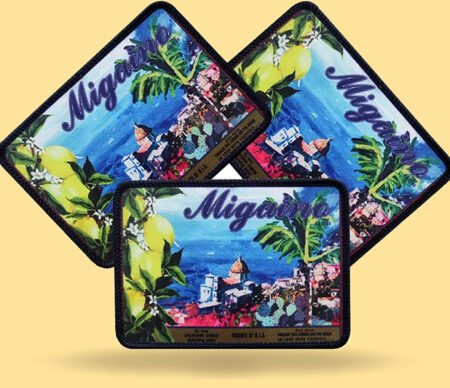
7 Ways to Style Sublimated Patches?
August 5, 2024
Benefits of Using Custom Embroidery Patches
August 5, 2024Raster vs. Vector Images: What’s the Difference?
For all the digital creators, photographers, and enthusiasts, the raster vs. vector image is probably a very serious debate. And although we might not be familiar with the intricacies, choosing the right type of image can make all the difference in the world.
Since visual aid has astoundingly remarkably affected marketing, both raster vs. vector images have a massive demand. And now that social media has taken over the world; people have started to prefer the visual and digital aspects of marketing.
Vector vs. raster images came into being almost simultaneously in the 1960s. And suffice to say, it was a great invention filled to the brim with unimaginable possibilities. Although both raster vs. vector images are used to illustrate digitally, the process of creation couldn’t be more different. Also, in order to understand the crucial differences between vector and raster, you need to first know what they are, along with their respective rendering process.
What are Raster Images?
Otherwise known as bitmap graphics, it is precisely what you think about when you are thinking of images. Raster images comprise of a compilation of colored, rectangular pixels or dots. These dots or pixels are then arranged strategically to make up a vivid picture.
Since these images are made up of pixels or dots, raster images are heavily resolution based. The resolution of an image is the number of pixels displayed per inch of the picture. Following that, the higher the resolution, the higher the number of pixels in the image. Thus, the image quality will be increased as well.
Due to the fact that this format of image can support a sundry range of colors and graduated tones, it is very well-suited for photographs or other images with ample details.
Examples of raster images are as follows:
- All photographs in print or online
- JPG
- GIF
- PNG
However, since raster images are solely reliant on resolutions, if you were to enlarge it without changing the resolution, the picture will become pixelated and blurry. The image density needs to change according to the intended use.
What Are Vector Images?
Also known widely as line art, vector images are as different from raster images as day and night. Mathematical formulas devise a vector image where raster images are comprised of pixels.
A very popular form of image in the 60s and 70s, vector images made a comeback not too long ago. These mathematically devised images are a popular choice for something as small as a business card and as big as billboard images.
This is because you are down-scale or up-scale vector art without compromising the quality of the picture. It is this independence from the resolution that boosted the rise of vector art.
Common usage includes vector illustrations for logos, animations, and animated texts.
Difference Between Raster and Vector Images
Regardless of whether you are familiar with the formats or not, it is very easy to distinguish between both the raster vs. vector images. They are visually as different as their processes of creation.
For those who are wondering about the more intricate differences, we have taken it upon ourselves to assemble a list of all the significant differences between the raster vs. vector debate.
File Size and Space Requirements
In comparison between the vector vs. raster, raster images are generally larger than vector files. This is because they have the ability to contain millions of pixels in a single embodiment. Not to mention the incredible details.
However, the ramifications of a high-density raster image are as follows:
- Considerable impact on-device storage
- Decrease in page loading speed
On the other hand, vector images are far lighter in weight. This is because they only consist of mathematical formulas.
Resolution
When it comes to a resolution in the raster vs. vector debate, it makes up for the most prominent difference between them. The resolution in raster images is referred to as PPI (pixels per inch) or DPI (dots per inch).
If you zoom in on an image without changing the resolution, the image will become pixelated and blurry. Therefore, the higher the resolution, the more detailed the image.
When it comes to vector files, the resolution is never an issue. Since vector files are made up of formulas, you are zoom in or out to your heart’s content; it will not affect the image quality. Due to this, vectors are avidly popular with images that need to appear in a number of different sizes.
Editing and Accessibility
One of the advantages of raster files, in the raster vs. vector debate, is that you can easily open them in various different apps and browsers. Not to mention how easy they are to edit, share or view. At the same time, vector images pose more of a challenge.
To edit a vector image, you need a specialized software to open the file. Suffice to say; vector files are not as accessible as raster.
Conversions
Even though it might be challenging, it is very possible to convert a raster file into a vector or vector file into a raster. The process of converting to a vector is generally known as vectorization. Another popular name for it is image tracing.
And as for converting to raster, the resolution required for upholding the image quality is of the utmost importance.
Uses of Raster Vs. Vector
The majority of the images clicked by digital cameras, viewed online on web browsers, or photographs are raster images.
In the raster vs. vector debate, vector files often comprise illustrations, graphics, and logos. This is majorly due to the quality of a vector image does not change regardless of what size it is.
Graphics of Raster Vs. Vector
No matter how detailed a vector image may get, you can never make it look real-life. And even if you tried, the process is tedious and elongated, requiring a new image for every color change or blend.
On the other hand, Rasterized images are more than capable of capturing life-like graphics. And they always tend to be visually perfect.
Extension Types of Raster vs. Vector
For raster:
- JPEG (Joint Photographic Experts Group)
- BMP (Bitmap Image File)
- PNG (Portable Network Graphics)
- GIF (Graphic Interchange Format)
For Vector:
- EPS (Encapsulated Postscript File)
- AI (Adobe Illustrator)
- EMF (Enhanced MetaFile)
Elegant Patches – Quality that is Unparallel
At Elegant Patches, as an online business that firmly revolves around all things patches and image related, we are here to fulfill all your graphic requirements. To make sure that we achieve customer satisfaction, we at Elegant Patches employ a number of graphic artists who are experts in their fields.
So, whether you want to create a vector image from scratch or you want to convert a vector file into a raster one, we are more than equipped to handle all your orders. Not only that, but we can also help you with orders regarding making a logo from scratch, a vector image of your wedding, etc.
The sky is the limit, and we at Elegant Patches love to soar amongst the clouds.





